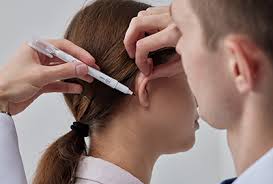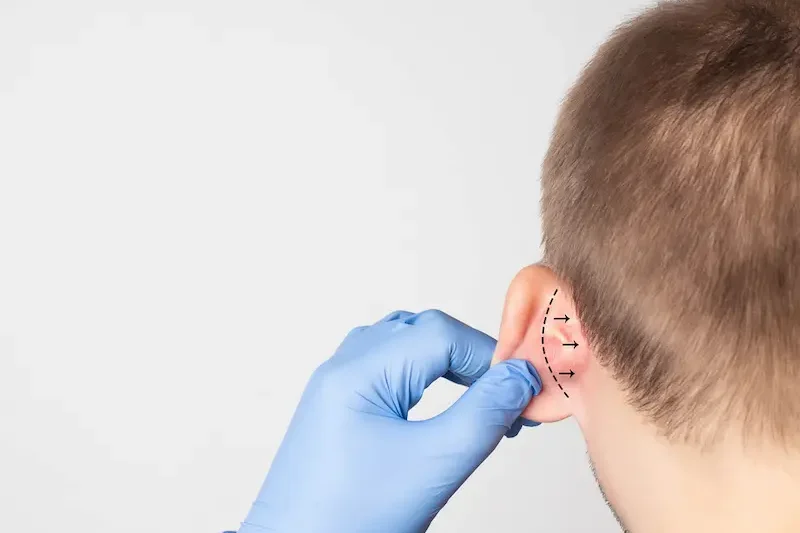Otoplasty In Turkey
Otoplasty which is also referred to as ear surgery or ear pinning has made Turkey popular among many people. This makes it an ideal place for people who want this kind of treatment due to its experienced doctors coupled with modern medical facilities juxtaposed with affordable rates. Istanbul is famous for medical tourists largely because there are dozens of well established clinics and hospitals dedicated exclusively on cosmetic surgeries like otoplasty.
Otoplasty Procedure
Otoplasty is a surgical procedure that is designed to reshape or reposition protruding ears. The surgeon moves them closer into position around your head making your ears look proportionate and natural at the same time. Typically, this process involves incision behind both ears; sculpting of cartilage and moving the location of the ear until they provide an aesthetic outcome as required. Otoplasty can be performed on children as young as five years old or adults of any age.


Types of Otoplasty in İstanbul Turkey
In Istanbul, Turkey, different kinds of otoplasty can help in addressing various ear worries. Here are a few types:
- Ear Pinning (Prominent Ear Correction): It’s usually done to reposition protruding ears back closer to the head so as to give it a more natural and proportional appearance.
- Ear Reshaping: This surgery reshapes ears by working on the cartilage which has deformity, asymmetry or irregular shape or size.
- Ear Reduction: Surgery for ear reduction works by removing excessive skins from large and prominent ears creating balance with other parts of the face.
- Earlobe Repair: This procedure is used to mend torn, stretched or deformed earlobes often caused by wearing heavy earrings or traumatic injury.
Postoperative Care Recovery
The recovery period following otoplasty in Turkey, Istanbul usually takes a few weeks. Swelling, bruising and pain around the ears for the first few days are to be expected. Specific post-operative instructions will be given to the patient such as head elevation, no strenuous activities and use of ear protector compressive cloth or dressing.
It is necessary to strictly adhere to the surgeons’ directions in order to accelerate healing and limit chances of complications. Although many patients can resume work and light activities within a week, it may take several weeks before they can engage in any strenuous exercise or activity that might affect their ears. With careful handling as well as patience, final results for otoplasty often become more apparent after some months showing a much improved harmonious and attractive ear shape.
Is Otoplasty Surgery In Turkey Safe
Turkey Otoplasty surgery in Turkey is believed to be generally safe if it’s done by experienced, highly skilled plastic surgeons in accredited medical facilities. In terms of its healthcare system and quality of medical services, Turkey has made significant progress and is now following international standards. Many hospitals and clinics within major cities such as Istanbul have been credited with Joint Commission International (JCI) and the Turkish Ministry of Health.

However, otoplasty just like any other surgical procedure has risks associated with it such as infection, bleeding, scarring as well as complications related to anesthesia. An otoplasty specialist who works at a fully equipped hospital will be essential; one that carries out the operation under sterile environment. Patients should conduct thorough research about their alternatives, read reviews concerning them and ensure that their safety protocols are adhered to by the medical team.
Otoplasty Cost In Turkey
That’s why many people choose to have an ear reshaping surgery in Turkey because they can save on costs compared to some other countries. The cost of having an ear reshaping surgery in Turkey differs between $2 000 and
$4 000 which may be significantly lower than prices offered in other countries like USA or Europe West for instance.
Nonetheless, it should be remembered that the prices may vary depending on the surgeon’s proficiency, method used, geographical location as well as additional procedures or treatments required. To make things simpler you might find a clinic that has package deals inclusive of the surgery, hospitalization and other luxuries.
Recovery For Otoplasty

It can take several weeks for patients to heal after undergoing otoplasty; hence they need to plan for a gradual return to their normal activities. There is usually swelling, bruising and some discomfort in the ear region a few days after surgery. Until healing is complete one may have to wear headband or dressing for support of the new position of the ear so as not to get accidentally displaced.
Within one week most patients can go back to work and engage in light activities but heavy exercises plus those which may impact on ears are however prohibited until three weeks later. It is important therefore to strictly adhere to what your surgeon tells you so that your healing process goes smoothly without any complications arising from non-compliance with instructions.
Aftercare For Otoplasty
Right care after ear surgery is key to a good healing. Doctors will tell patients how to look after their wound, use drugs, and what not to do. In short, care may include:
- Keeping the cut area clean and not wet to stop infection. This means doing what the doctor says for cleaning and covering the cuts, and not doing things that could get the area wet or dirty.
- Using pain killers and germ-killing drugs as told. It’s very important to take the right amount and at the right times to help with pain and stop infections while healing.
- Putting on cold packs to bring down swelling and feel better. Cold can ease swelling and bruises, which often happen after ear surgery.

- Not doing things that could move the ears or mess up healing. People might need to avoid hard workouts, sports where they might hit, or things that might bump the ear.
- Going to check-ups for watching and changing dressings. Seeing the doctor often is important to keep an eye on healing, fix dressings, and take care of any problems that come up.
Following the doctor’s care tips is a must for a smooth healing and to get what you want. Being patient is important too, as healing can take many weeks or months for the end result. Patients should quickly talk to their doctor if they notice anything odd or worrying during healing, as quick help can stop more problems and help heal better.
For whom is the otoplasty suitable?
Ear surgery, or ear pinning, fits those who don’t like how their sticking out or oddly shaped ears look. Kids and grown-ups can both get this to look better. Check out who often gets ear pinning:
Kids: Even little ones, around five, can get the surgery to fix ears that stick out too much. Getting it done early is a good idea to stop mean comments or feeling bad because of how the ears look.
Grown-ups: Any adult who feels uneasy about their ears’ size, form, or where they sit might choose ear surgery. It’s a way to feel better about yourself and make your face look more even.
People born with odd ears: Some folks come into the world with ear shapes that aren’t the norm, like lop ear, cup ear, or other odd forms. Ear surgery can make these better and help the ears look nicer.
Those with hurt ears: If you’ve hurt your ears or they’ve been harmed by things like burns or other bad stuff, ear pinning could make them look more like they used to.
It’s key to remember that ear surgery is mostly for looks and not so much for people with deep health issues or really bad hearing problems that need different kinds of help.
Risks and Side Effects of Otoplasty
As with any surgical operation, otoplasty carries certain risks and potential side effects despite being generally safe. These include:
Infection: An infection may develop at the surgical area, however this can be reduced through proper postoperative care.
Bleeding: After surgery there may be some bleeding or hematoma (pockets of blood) which need further management.
Scarring: Incisions are made behind the ears during otoplasty which creates visible scars. However expert surgeons try to minimize scarring by making incisions in concealed areas.
Asymmetry: The ears might not look perfectly symmetrical after the procedure in some cases although accomplished surgeons strive for a balanced and natural appearance.
Numbness or altered sensation: There can be temporary numbness or altered sensations around the ears because of nerve disturbance during surgery, but this usually subsides over time.
Recurrence: Rarely, the ears may stick out again gradually requiring revision surgery.
Anesthesia risks: Like any other surgical procedures involving anesthesia there could be risks related to the anesthesia itself such as allergies to drugs or reactions to drugs that one is sensitive to.
You must talk about all possible dangers and bad results with a skilled and learned plastic doctor when you meet with them. Doing what the doctor tells you and going to all check-up meetings can help cut down on problems and make sure you get good results.
Reasons to prefer Otoplasty
Some common reasons why people may opt for otoplasty (ear surgery) are as follows:
- Boost self-confidence and self-respect: Stick-out or misshaped ears can be a source of distress and unease, particularly among young children and adolescents. Hence, by rejuvenating the appearance of ones’ ears, it helps them to feel better about themselves and thereby develop a positive attitude towards life.
- Rectify congenital ear deformities: Some individuals are born with lop ear, cup ear or other irregular formations of the ear. These can be corrected through otoplasty in order to restore the normal look and make them more attractive.
- Cure protruding or prominent ears: Some people do not like having their ears stand out too much from their heads. By repositioning them near the head, an otoplasty gives your facial features balance as well as proportion.
- Improve ear symmetry: In case one has uneven or ill-shaped ears, probably larger on one side than the other; an otoplasty is carried out so that symmetry is maintained across both.
- Correct damage caused by trauma to the ear: People may want to get an otoplasty done if they have gone through accidents, burns or any other form of physical disfigurement that causes changes in shape of their pinnae as it will help bring back the normal shape of their ears.
- Personal preference or aesthetics: Other people only just like it when their ears have a different shape or are positioned differently, for whatever reason of personal beauty, and otoplasty is one way of achieving that perfect look they strive for.
- Prevent bullying or teasing: Bullying and teasing can be directed to children and teenagers who have protruding or misshapen ears. This kind of problem may be resolved through otoplasty and psychological distress avoided altogether.
- Improve hairline or hairstyle: Sometimes, having ears sticking out makes it difficult for one to make certain hairstyles with the hair on top becoming a worry. The image of an individual’s face will change after otoplasty giving him/her chance to wear his/her hair in different fashions.
However, this procedure is something that one would choose only after it has been done by the professionals who are well conversant with seeking such direction but not because there is a cosmetic concern regarding those ears.
Conclusion
Otoplasty changes how your ears look if they stick out or are not shaped right. In Turkey, mainly in the city of Istanbul, you can find good doctors and pay less for this kind of work. There are some risks, but they’re small if you take good care and pick a doctor who knows what they’re doing. Want to feel better about how you look? Think about ear surgery and talk to a trusted doctor in Turkey.
Contact us today and get the best offer!
Read Also:

